Auger drilling of wells: features of technology and shell for manual drilling and installation
Screw drilling of wells for drinking water is the most popular way of drilling today on the territory of private households. It is possible to independently arrange a shallow aquifer with the help of a manual earthen drill. To facilitate work, often use small-sized drilling rigs with a drive.
We will explain why this method is so popular. We will analyze how it differs from other methods of drilling, in which situations it is effectively used. The article describes in detail the screw technology and design of drilling equipment, as well as drilling tools used in manual and mechanical drilling.
The content of the article:
The specifics of auger drilling
A borehole is a working out of a cylindrical shape in the earth's crust, which with a large extent has a small cross section. Its beginning is called the mouth, the lateral surface is called the walls, and the bottom of the mine is called the bottom.
The optimal method of drilling is chosen taking into account the functional purpose of the well, the desired diameter and depth. It is important to take into account the physicomechanical properties of the rocks that must be passed in the process of formation of the water intake.
The technical and economic feasibility of drilling in specific conditions also affects. This is a significant stage in the design of wells, during which the basic technological solutions are determined - the type of equipment used and drilling modes.
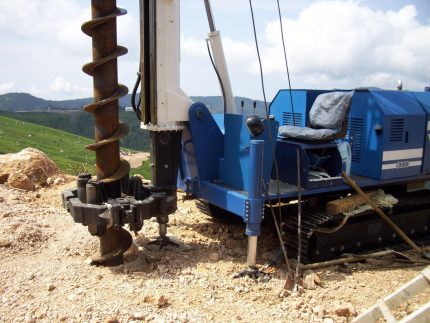
When designing and subsequent drilling of water wells, it is necessary to focus on long-term use. The ability to maintain a stable debit and constant water permeability of the bottomhole zone for a long period of time is important.
The well drilling process includes several operations:
- Destruction of the rock at the bottom, that is, the separation of particles from the array.
- Transportation of waste soil to the surface.
- Preparing the well for operation by cleaning and arranging the well, as well as water extraction flushing.
The effectiveness of drilling directly depends on the physical and mechanical properties laid down by nature, namely: the density of addition, porosity, permeability of incoherent soils, the consistency of clay cohesive rocks.
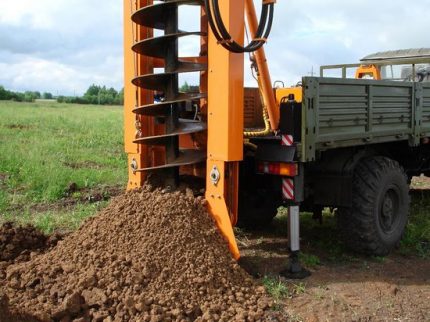
For drilling rock, characterized by monolithic and crystalline type of bonds between particles, this method is not suitable. The stronger the consolidated mineral grains in the rock, the more work is spent on its destruction.
Advantages and disadvantages of the method
Auger drilling is used in industry, and in civil engineering, and in manual drilling. Its distinctive feature is the removal of the destroyed rock not by washing liquid or special gas-liquid mixtures, but directly by the details of the screw projectile.
Distinguish vertically and horizontally directed auger drilling. The first method is used for the construction of aquifers, as well as for the formation of holes for piles. The second - is used when laying engineering communications in a trenchless way.
This method provides at the same time a high penetration rate in non-rocky soils to a depth of 50-80 meters, which allows you to immediately form the working walls by installing a casing string.
Another plus is the extraction of waste soil to the surface without lifting the tool. And one more thing: since no drilling fluid is needed for auger drilling, it is successfully used in anhydrous regions, and is also used in periods with a predominance of low temperatures.
Today, drilling with auger aggregates is used:
- For the device of individual water wells;
- In the construction of foundations from screw / bored piles;
- For the installation of fences and reinforced concrete supports;
- When performing trenchless laying of communications;
- For the construction of shallow wells and pits.
However, there are also disadvantages. It is impossible to drill a well in high hardness rocks with screws. When sinking in hard and semi-solid loams, clays with interlayers of limestone, complications can arise, and when drilling abrasive rocks, a large consumption of drill bit is noted.
In addition, there is a restriction on the depth of production. It is very difficult to build a well with a depth of more than 80 meters in this way.
Vertical Mining Technology
The auger is a high-strength drill pipe with a coiled spiral, which serves as a vertical screw conveyor. Under the action of axial load, the working part of the drill is introduced into the rock and destroys it by cutting and loosening. At the same time, the auger drill feeds the waste soil to the auger spiral.
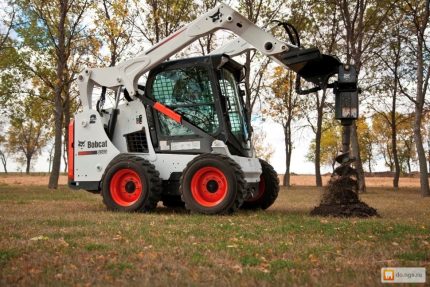
Under the action of centrifugal forces, the loosened soil rises up the blades of the drill string. The rise is due to sliding in a spiral, since the friction of the soil on the screw is less than on the walls of the well.
So the destroyed rock is delivered in a crushed state from the bottom to the surface, and is thrown out through the wellhead.With uncomplicated transportation, the soil fills 30-40% of the total inter-turn space.
The parameters of the screw columns should provide a quick rise of the entire mass of soil destroyed by the screw. However, during drilling, part of the loosened soil crumbles back to the face. Therefore, when performing auger drilling, a more enhanced cleaning of the barrel is required, and upon completion, mandatory washing is required.
Horizontal directional auger drilling
When installing utilities of various functional purposes under obstacles (highways, railways, forests), horizontally directed auger drilling is used.
At the initial stage of work, two pits are excavated - the starting one (working) and the receiving one. They should be at the same level with the designed well. After that, the necessary equipment is lowered into the working pit and mounted.
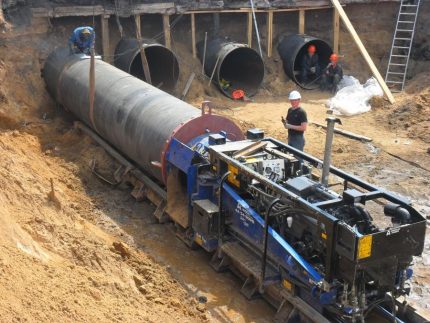
Such equipment has a long feed stroke and is equipped with a wear-resistant drill head made of high alloy steel. It also has a probe to track drilling. Receiving signals to the monitor, the operator controls the process and can adjust the direction of movement, as well as the angle of inclination of the drill head.
When the auger enters the receiving pit, that is, the end point according to the project, the drill is removed. Instead, the expander and pipe are fixed. After that, the rotation of the blades in the opposite direction is started to tighten the pipe into the finished well. At the end of the drilling work, a screw installation is removed from the starting pit.
The trenchless method allows pipes to be laid under communications below groundwater level up to 80 m long. Moreover, all complex work is carried out without the laborious development of trenches, which makes it possible to minimize execution time and reduce financial costs.
Horizontal screw drilling is used when laying pressure pipelines and installing communication systems in areas where laying by other methods is impossible. Main advantage trenchless laying - profitability. In addition, there is no need to use concrete or other polymers to maintain the stability of the finished mine.
Features of drilling in different rocks
The basic technological parameters of well drilling are the axial load and the rotational speed of the screw of the screw conveyor. When the load increases, the penetration rate will certainly increase, which can lead to various emergency situations.
Therefore, it is imperative to ensure that the volume of rock separated per unit time does not exceed the conveyor capacity. Otherwise, traffic jams form on the turns.

As a rule, clayey clay rocks, loose and medium density sands are drilled without forced thrust. The screw tool is introduced into the soil under its own weight, as well as due to the reactive force arising from the supply of waste rock to the mouth of a cylindrical mine.
Axial loads of up to 5 kN are usually created during start-up drilling of a well, when drilling in solid sandy loams, loams, clays, mudstones, and siltstones. The column rotation frequency should not exceed 1.7-3.3 s-1.
At higher frequencies, vibrations occur inside, due to which the links of the drill string may lose connection. As a result, the drill will remain at the bottom, it is almost impossible to get it, which means it will have to drill a new mine. And at low frequencies, transportation of waste soil to the top is very difficult.
With increasing hardness of rocks, axial loads increase. Drilling in gravel and wood-gravel soils, frozen loams, water-saturated sands, siltstones with the inclusion of quartz is carried out with an axial load of 8-10 kN per bit and a column rotation speed of 1.3-2.2 s-1.
Pebbles and rocks with the inclusion of boulders by the auger method are not drilled. These rounded rock fragments are destroyed with a chisel and lifted to the surface by a bailer.
Drilling in sands of various densities and degrees of saturation with water, gravel and gravel deposits is carried out at high speeds and at the same time strengthen the walls of the casing with casing.
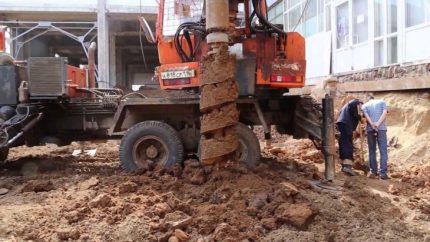
To avoid this, reduce the drilling speed to the minimum possible, pace the string and add water to the well. Also, in a similar situation, the periodic lifting of the drilling tool to the surface and cleaning of adhering loam helps.
Auger Drilling Tools
Tools for auger drilling of wells by type of construction are distinguished by the number of turns and the geometry of the cutting part. For drilling in solid and semi-solid sandy loam and loam, drill shells are often used, the edge of which is equipped with additional incisors.
Most often, only one starting auger without any additions is used for driving private water intake for private traders, as drilling will have sedimentary cohesive and incoherent rocks. When deepening, the tool is simply extended with drill rods.
In this case, the projectile is removed from the wellbore every 0.5 - 0.7 m to clear the drill itself and the bottom from the destroyed rock. This is a more economical, but also more laborious, option for drilling.
To drill boulders and pebbles that can be found in sedimentary soils, they switch to the shock-rope method. As a rule, a chisel made of tool steel is used for this. This drill, pointed from the bottom, is “thrown” into the face with force until it destroys the “solid barrier”.
After the destruction of the pebble or boulder, the fragments are removed to the surface with a glass (core pipe) or bailer. Then they again switch to the screw method. Most often, for drilling a mine, one has to use several drilling methods in combination.
When drilling loose sands and soft loams, drilling augers are used with blades turned towards the bottom for angles of 30-60 °, and for drilling in cohesive clay rocks - 90 °.
This spiral is obtained by winding high-strength steel tape with a diameter of 5-7 mm on a screw mandrel. It is stretched on a pipe / rod, and then welded.
The larger the diameter of the base pipe, the lower the conveying capacity of the screw. However, the diameter of the long product is limited by the mechanical strength of the screw, as well as the technology of its production.
Today, two types of screws are manufactured:
- With a central hole, i.e. hollow;
- Weighted - no hole.
To minimize wear of the screw conveyor during drilling in abrasive rocks, a steel strip is screwed onto the outer edge or a metal layer is deposited on the surface.
At high speeds of auger drilling above the shell, a special adapter with two-way winding of strip steel is fixed. In this case, the bulk of the rock falls on a screw conveyor without grinding.
At the end of the pipe with a wound spiral, the connection elements are necessarily welded. There are two types of screw connection: threadless and threaded.In the first case, the screws are connected with clutch locks and held at the expense of metal fingers with clamps, in the second case - by screwing.
The threaded connection of the screws into the drill string makes it possible to mechanize their connection and disconnection when performing hoisting operations, when supplying liquid to the face. But there is a significant minus - there is no possibility of reverse rotation of the screws in this case. And therefore, a threadless connection has become more widespread.
Special drilling rigs, as a rule, include a set of screws of different diameters.
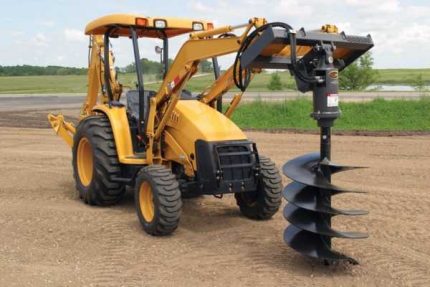
Hollow screws with a threaded type of connection are used during drilling with a purge, for pumping water during the excavation of cylindrical workings in the earth's crust, for installing a charge in geophysical wells, for pumping concrete into openings under piles. They can also be used as casing.
When drilling with a continuous face, the central channel is blocked with a drilling tool on a rope.
Drilling Rig Overview
For screw drilling use as hand toolsand mechanized installations. The simplest in design is a manual earth drill. It consists of a rod / pipe with a screw-shaped knife and a rigidly fixed T-handle.
This type of boring tool is screwed into the ground like a corkscrew. In the process of driving a mine, it is increased with bars. Manual earth augers are made collapsible so that it is most convenient to transport them in passenger cars. It also allows you to change the length of the auger drill string.
With a hand tool, you can make holes up to 2 meters deep with a diameter of not more than 20 centimeters. There are motor drills with gasoline or electric drive. Their design includes a screw conveyor, that is, a screw, and an engine with a gearbox. The rotation of the motor shaft provides the movement of the auger.
Using a power tool in the presence of drill rods for building, you can drill wells up to 25 meters deep. With a diameter of up to 30 centimeters it is used for the installation of street lighting poles, for the installation of pillars of fences, pits for the inspection of the foundation, soil base.
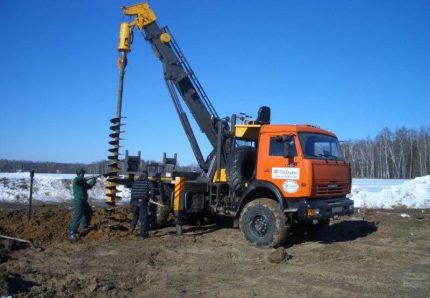
Mobile units are small-sized machines with an electric or gas motor. With their help, you can quickly drill well for giving prepare a large number of pits for supports of various functional purposes.
Often such drilling rigs are made in the form of a trailer for passenger cars to facilitate transportation to the place of work.
In civil and industrial construction, for the formation of workings of great depth and diameter, screw special equipment is used, fixed on mobile equipment - trucks, tractors.
It is used in the installation of pylons for high-voltage power lines and street lighting poles, when installing pylons for stadiums, sports centers, industrial facilities, and airfields. In addition, with the help of auger drilling rigs, tongue and groove fencing of pits is built on mobile equipment, screw piles are installed.
Useful video on the topic
Auger drilling of a water well 20 m deep in a private household:
This video shows the technology of horizontal auger well drilling for laying communications under the highway:
The device of piles with a continuous auger of large diameter with a central channel.For work, the Bauer BG-30 drilling rig and the Liebherr high-performance stationary concrete pump are used:
The screw method provides high rates of well drilling. The development of the well and the supply of waste soil from the bottom to the mouth of the development takes place simultaneously and continuously, which saves time, and the efforts of drillers, and the funds invested in the project. Therefore, the method of screw drilling is also popular.
Please leave comments in the block form below. Tell us if you had to use a hand-held auger tool or drill on a small-sized drilling rig using a screw. Share technological subtleties that may be useful to site visitors.

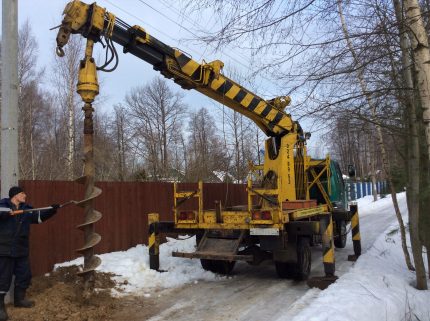
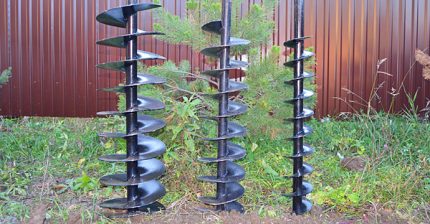
 Rotary Well Drilling: An Overview of Drilling Technology and Essential Equipment
Rotary Well Drilling: An Overview of Drilling Technology and Essential Equipment 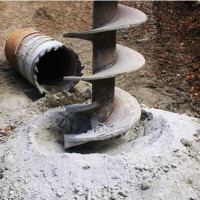 Methods of drilling wells: technological principles and features of the main methods
Methods of drilling wells: technological principles and features of the main methods 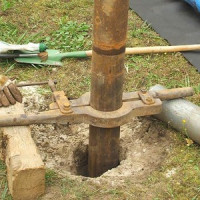 Manual drilling of wells for water: how to drill water intake manually
Manual drilling of wells for water: how to drill water intake manually 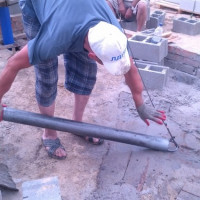 Drilling a borehole: a complete overview of shock-rope technology
Drilling a borehole: a complete overview of shock-rope technology 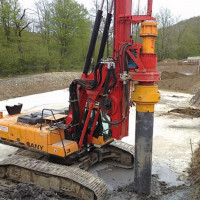 Core Well Drilling: Technology and Work Nuances
Core Well Drilling: Technology and Work Nuances  DIY drilling rig: making a homemade drill for drilling wells
DIY drilling rig: making a homemade drill for drilling wells  How much does it cost to connect gas to a private house: the price of organizing gas supply
How much does it cost to connect gas to a private house: the price of organizing gas supply  The best washing machines with dryer: model rating and customer tips
The best washing machines with dryer: model rating and customer tips  What is the color temperature of light and the nuances of choosing the temperature of the lamps to suit your needs
What is the color temperature of light and the nuances of choosing the temperature of the lamps to suit your needs  Replacement of a geyser in an apartment: replacement paperwork + basic norms and requirements
Replacement of a geyser in an apartment: replacement paperwork + basic norms and requirements
Auger drilling using technology is the best option for shallow wells. No wonder the method is popular. As for manual drilling with a screw, this is for masochists, or when there is absolutely no money, and the well is very necessary.